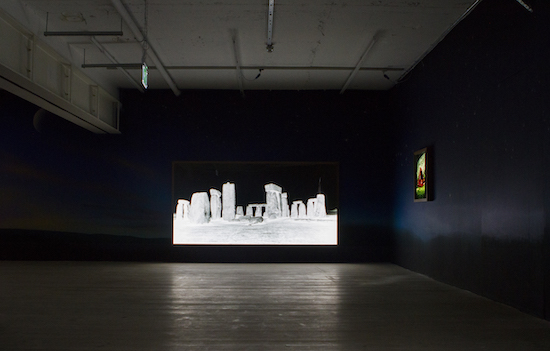Photos: Naomi Martin
Opposite the Australian embassy on the Strand a doorway opens between an image of standing stones. In the interior darkness, steps lead below ground level into a series of connected rooms like the chambers of a Neolithic barrow. At the furthest extent, where archaeologists might expect to find a sacred burial or hidden treasure, a well-stocked shop rings with the cheery beep of contactless payments.
Wiltshire Before Christ is a temporary exhibition at The Store X hosting Jeremy Deller’s collaboration with Sofia Prantera of the fashion brand Aries. In luminous backlit photographs by David Sims, models adopt moody and mystical poses amongst the megaliths of Avebury and Stonehenge. Their hooded streetwear is decorated with the shape of obsidian axe-heads, the cup and ring motifs of prehistoric art, and the bony phallus of the Cerne Abbas Giant. Sims’s photographs hang on walls decorated with kitsch landscape murals depicting sunsets, swirling clouds and starry skies. Central vitrines contain prehistoric artefacts borrowed from Salisbury Museum. A film about time-travelling plays on a loop, and a cardboard druid spins in the darkness. A considerable amount of work has gone into creating what Deller has called ‘an environment conducive to buying a T shirt’.
The project has its origins in Deller’s work with English Heritage last summer to mark the 100th anniversary of Stonehenge’s donation to the nation, and Deller is alert to and interested in the site’s containment by forms of exclusive and xenophobic nationalism. As what Deller describes as ‘the greatest logo or trademark in the world’, with more brand recognition ‘than almost anything in Britain short of the Queen’, Stonehenge is often categorised as the icon of the nation. The book that prospective UK citizens have to revise before they take their citizenship test contains a large image of Stonehenge, and the prehistoric site featured prominently on the front page of The Sun as it urged its readers to vote for ‘Great Britain’ not ‘Great Betrayal’ on the day of the Brexit vote.
While Deller’s 2012 bouncy-castle Stonehenge poked fun at the solemnity and gravitas of a national monument, Wiltshire Before Christ gives life to some alternative narratives. Attentive to a long history of population movement, replacement and exchange since the end of the last Ice Age, Deller adapts a Kinneir and Calvert sign for the A303 to read ‘Built by immigrants’. Tie-dyed T shirts carry the same slogan; another begins a periodisation ‘Paleolithic / Mesolithic / Neolithic’ and ends it ‘European Endless’.

To Deller, pre-Christian is also pre-national, and pagan aesthetics provide a way of untethering the prehistoric landscape of central southern England from official versions of nationalist history. Wiltshire Before Christ juxtaposes posters from the Stonehenge Free Festivals of the 1980s with archaeological evidence of feasting from the late Neolithic: Stonehenge becomes a place to come together and have a good time. Joining up some of the dots between prehistoric ritual and the rave, Deller sketches possibilities for living and being together that have deeper roots than nationalism, and which make a direct challenge to its claims on geographical place and cultural heritage.
Institutions like English Heritage continue to provide conservative and tourist-friendly versions of a national story, and there remains a conflictedness in Deller’s relationship that he acknowledges with giant suspended perspex logos of English Heritage and the National Trust. As in English Magic, his 2013 show for the Venice Biennale, Deller’s alternative versions of culture are sometimes caught up and intertwined with the institutions and perspectives he wants to critique. There are compromises to make in being a public artist like Deller, and there is an appropriateness to the fact that the mysterious, spiritual journey into the barrow tomb of Wiltshire Before Christ is designed around a shopping experience.
Wiltshire Before Christ is above all about merchandising. Its shop’s inner sanctum offers up an alternative version of an English Heritage gift shop. Racks of Aries T shirts, sweatshirts and tote bags are accompanied by shop vitrines selling versions of gift shop knick-knacks: mugs, socks, stickers, parcel tape, baseball caps and branded pencils. Only that stalwart purchase of the school trip – the pencil eraser – is missing from display. Not all of these products are particularly commercial (I went to the exhibition four days after the opening and they’d only sold two stone-effect iPhone covers), but they are a neat symbolic intervention into the commercial space of English Heritage. These products ask questions about the stories the heritage industry tells about the past, who it belongs to, and who gets to make a claim on it. They enliven and make strange the cherished artefacts of middle-England, widening the demographic to whom the distant past might hold meaning.
Deller’s commercial engagement here is populist and democratising: his show recognises consumer culture as an important site for transacting identity and belonging in the contemporary world. By acknowledging and embracing Stonehenge as a logo, trademark or brand, Deller does not cheapen prehistoric Britain so much as recognize its particular affordances in the here and now. This is an acknowledgement that remains fundamentally open to the fact that Stonehenge has not always been these things, nor will it continue to be these things forever more. As it acknowledges pre-national pasts, prehistory’s temporality opens up post-national futures to which a site like Stonehenge will just as inevitably be a part.
Wiltshire Before Christ is at The Store X, 180 Strand until 27 January. The exhibition will later tour to Milan in February, The Store X Berlin in March, before travelling to Tokyo and Florence


